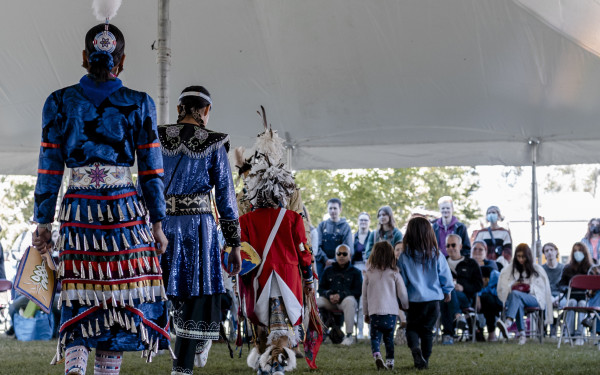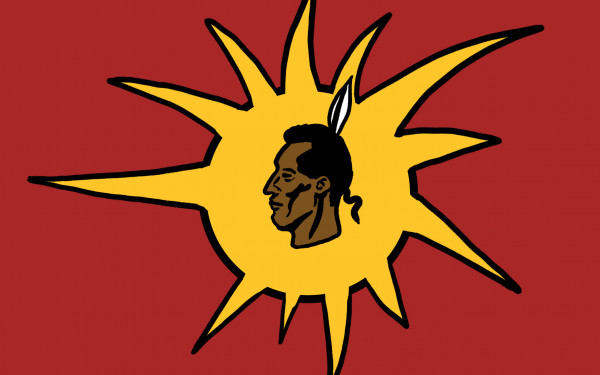Call Him Doctor Now
A Mohawk Leader Who Dedicated his Life to Community Receives Concordia’s Recognition
It’s probable that Kenneth Deer’s phone rings often. “People ask for advice all the time,” he quips. One phone call last November, however, was not one he thought he would ever receive.
On the line was a secretary from Concordia University who said the president wished to ask him a question. Slightly perplexed, Deer assumed it was about a political endorsement or guidance on curricula in regards to Aboriginal peoples.
Instead President Alan Shepard, a soft-spoken man, asked him if he would accept an honorary doctorate from the university.
“I was floored,” Deer recalls.
Deer immediately asked why, to which Shepard responded that it was for his lifetime of work. A rather simplistic answer. Even an introduction by professor Daniel Salée before Deer’s convocation address in May could not fully capture what Deer has accomplished.
As a Mohawk educator, activist, entrepreneur, journalist and writer, Deer is used to being part of historical movements and projects in the Kahnawà:ke territory south of Montreal.
In 1978, he helped create the Kahnawà:ke Survival School to serve 300 Mohawk students who were mandated by Bill 101 to be taught in English and French. The school still stands today.
In 1987, he went to Geneva for the first time to help enact change within the United Nations Centre for Human Rights. Representing the Iroquois confederacy—which includes the Mohawk, Oneida, Onondaga, Cayuga, Seneca and Tuscarora First Nations—he became an integral figure in the international battle for indigenous rights.
He continued to visit the Swiss city multiple times a year until 2007, when the UN General Assembly finally passed the Declaration on the Rights of Indigenous Peoples.
“The UN moves at the speed of a glacier, but it does move,” he comments about his experiences.
Only four nations voted against the Declaration: the U.S., Australia, New Zealand and Canada. In these countries, Deer says the idea of “Cowboys and Indians” is still pervasive.
“A lot people are really surprised to see we’re still around and ask why we are still a problem,” he says. “We’re resisting assimilation, and I think that irritates people a little bit—I don’t understand why.”
In 1992, having no journalistic background, he founded the Eastern Door, a newspaper created for the local Mohawk community of approximately 8,000 people. The goal was to have their own media outlet share their stories after “slanted and anti-Mohawk” coverage by mainstream outlets during the Oka Crisis—a 78-day standoff between Mohawk activists, police and the army over land ownership.
“We felt we needed a platform the community could depend on,” Deer says.
“There was a vacuum,” says Joe Delaronde, the communications officer for the Law and Council of Kahnawà:ke. “In the past, coverage of our issues was far less satisfactory than it is today.”
In the very beginning, Deer and a small group of volunteers ran the paper out of his dining room. After receiving a small government grant, they tore down his garage and built a one-storey office space.
“The car was never in there anyway,” he recalls. “Even when we moved in, we knew it was too small.”
The Eastern Door was biweekly back then, and they only had one Mac II computer to work with. Deer was doing everything: writing, advertising, laying out the paper. He would sell enough corner page ads just to be able to publish the next issue.
He took night classes to learn basic layout, while professors from Concordia’s journalism program voluntarily gave lessons on basic news writing to the staff. This crash course on how to run a newspaper became easier when Deer hired Ni:ne McComber Bush, who he calls his “godsend.”
McComber Bush, coming from a background selling ads for the local radio station, became their first sales representative. “Talk to anyone who runs a newspaper, [a salesperson] is worth their weight in gold,” Deer says about her hiring.
Those early days of pulling all-nighters and surviving issue by issue were, as McComber Bush describes, “a lot of fun and new.” She says Deer gave her carte blanche, which made selling ads easy with her extensive contacts.
Deer set a goal to have a single issue sell 1,000 copies, and they broke it by Christmas of their first year. “For a small community, we were doing very, very well,” he says. The Eastern Door’s existence stabilized, gradually growing into a weekly publication, having a full-time paid staff and adding a second storey to the office.
Greg Horn, who interned at the paper during his summer break from university in 1997, credits his time there for discovering his passion for journalism. He calls Deer one of the “best community journalists around” with his unbiased reporting of Kahnawà:ke council decisions.
“Kenneth was a big part of getting people to realize it’s important to have our own media outlets and tell our own stories,” Horn says.
Delaronde, who has been working for the council of Kahnawà:ke for 11 years, says the Eastern Door has never been “about Kenneth.” Deer could both criticize and praise council decisions when deserved, Delaronde adds.
“In spite of his well known personal beliefs, he put a paper together that reflected the views of many different people,” he says about Deer.
The Eastern Door to this day is the Mohawk community’s journal of record and reading the paper every Friday has become a “habit,” according to Delaronde.
The aspect of the job Deer remembers most fondly was his editorials on the most newsworthy topic of the week. Deer refers to them as “little parables” that could impact social change.
“[He] always kept himself out of the editorial,” Delaronde says. “It was always about the issues and his educated take on what he was seeing.”
Sometimes when Deer reads old stories, he becomes surprised to see his name in the byline, which makes him wish he could write that way again.
Deer sold the paper in 2008, and the Eastern Door has seen two location changes since. Some of the original staff still work there, like McComber Bush who is going on 23 years.
Horn founded his own newspaper, Iorì:wase, which also serves the Mohawk community of Kahnawà:ke. Most of his initial staff came from the Eastern Door—a fact that allows Deer to jokingly say that he founded two papers.
Before receiving his honorary doctorate and giving a convocation address, Deer’s son Bryan gave a speech in Mohawk about his father. The two embraced before the elder Deer took to the podium.
“In our tradition, when we give thanks to creation, we also have to think about what is our role in creation,” the newly honored doctor told an audience of Concordia graduates and their families in June. “What is your role in creation? That is a fundamental journey that you’ll have to take for the rest of your life.”
McComber Bush says hearing about the news was as if she learned her uncle was receiving an award and calls his honouring a “feather in the cap for the whole community.”
“Doctor Deer is what I call him now,” she jokes.

_900_643_90.jpg)
_600_832_s.png)


_600_375_90_s_c1.JPG)

